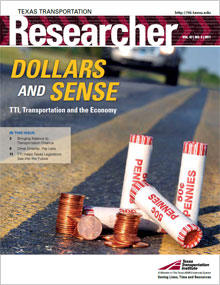Improving pavement performance has been a primary goal of the Texas Transportation Institute (TTI) since its founding in 1950. And we’re not done yet. The latest innovation is a mechanistic method of simulating pavement behavior and predicting pavement damage that can help produce longer-lasting, distress-resistant pavements.
“There has been a continuing effort to replace empirical methods of pavement design and analysis with more mechanistic approaches,” says Dallas Little, TTI senior research fellow and professor in Texas A&M University’s Department of Civil Engineering. “The mechanistic method is based on fundamental aspects of pavement mechanics, as well as the properties of the material components that comprise asphalt pavements, such as asphalt binder, mastic and aggregate.”
TTI has researched and developed this new method as part of the Asphalt Research Consortium (ARC). The Federal Highway Administration is funding the consortium with $27 million over a five-year period to evaluate asphalt infrastructure performance.
This project developed the state-of-the-art, three-dimensional computational code called the Pavement Analysis Using Nonlinear Damage Approach (PANDA). PANDA has a wide range of uses to predict when and where pavement damage will occur to help build better pavements.
“PANDA offers substantial improvements in modeling capabilities,” says Michael Harnsberger, principal scientist at the Western Research Institute. “It will have a great impact on the pavement design community in selecting materials and modeling performance.”
PANDA can simulate the behavior of pavements and predict pavement performance, including fatigue damage, permanent deformation (better known as rutting) and overall life span. PANDA considers the impact of moisture intrusion, aging, healing and temperature on how the asphalt composite mixture responds under traffic. Users of PANDA can see graphically (from color contours representing levels and locations of damage in the pavement) how the pavement responds under regional environmental conditions. This approach allows the user to readily compare the utility of various material constituent combinations.
One unique feature of PANDA is that, rather than considering the pavement as a continuum, it can focus on the microstructure of the asphalt mixture. This helps the pavement engineer to assess specific mechanisms that can cause failure or to define the weak link in the design.
“Our vision is for wide use of PANDA, both within the United States and around the world,” says Rashid Abu Al-Rub, TTI assistant research engineer. “The results are easy to evaluate even if the user isn’t knowledgeable about mechanics.”
The research team, which also includes Research Engineer Eyad Masad at Texas A&M University–Qatar, is completing software development and performing validation in both field experiments and laboratory tests. Work continues to make the model more user friendly for widespread use.
Little is quick to praise TTI Research Engineer Bob Lytton for his tireless leadership and guidance in advancing the understanding of mechanics and fundamental properties. These are the bases for PANDA and help fuel ARC research in many other important areas.
